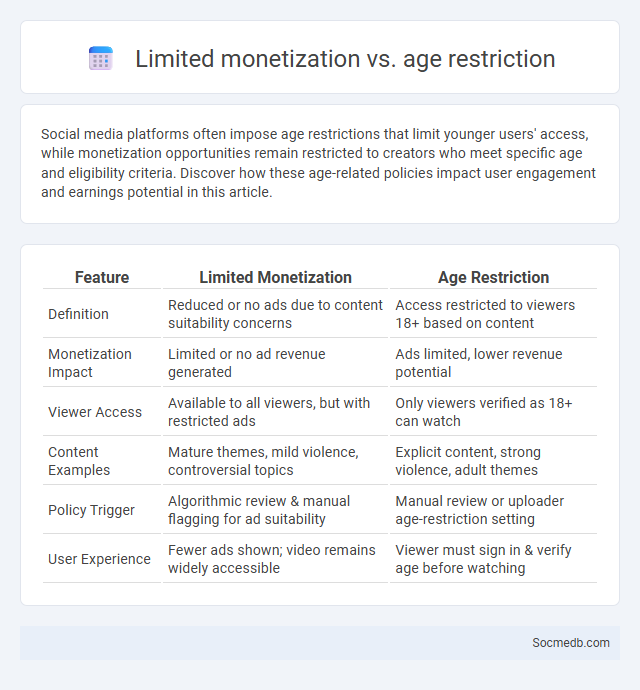
Photo illustration: Limited monetization vs Age restriction
Social media platforms often impose age restrictions that limit younger users' access, while monetization opportunities remain restricted to creators who meet specific age and eligibility criteria. Discover how these age-related policies impact user engagement and earnings potential in this article.
Table of Comparison
| Feature | Limited Monetization | Age Restriction |
|---|---|---|
| Definition | Reduced or no ads due to content suitability concerns | Access restricted to viewers 18+ based on content |
| Monetization Impact | Limited or no ad revenue generated | Ads limited, lower revenue potential |
| Viewer Access | Available to all viewers, but with restricted ads | Only viewers verified as 18+ can watch |
| Content Examples | Mature themes, mild violence, controversial topics | Explicit content, strong violence, adult themes |
| Policy Trigger | Algorithmic review & manual flagging for ad suitability | Manual review or uploader age-restriction setting |
| User Experience | Fewer ads shown; video remains widely accessible | Viewer must sign in & verify age before watching |
Understanding Limited Monetization on Online Platforms
Limited monetization on social media platforms often results from strict content policies, ad revenue-sharing models, and algorithmic visibility constraints that restrict creators' earning potential. Your ability to generate income is influenced by platform-specific rules, audience engagement metrics, and the types of content you produce. Navigating these limitations requires strategic content planning and diversification of revenue streams beyond traditional ad-based monetization.
What Does Age Restriction Mean for Content Creators?
Age restriction on social media limits the visibility of your content to users above a certain age, affecting reach and engagement metrics crucial for growth. Content creators must comply with platform guidelines to avoid demonetization or account suspension, which can severely impact revenue streams. Understanding how age restrictions work enables you to tailor your content effectively, ensuring it reaches the appropriate audience while maintaining compliance.
Key Differences Between Limited Monetization and Age Restriction
Limited monetization restricts your ability to earn ad revenue on social media due to content that violates platform guidelines but doesn't fully breach policies, while age restriction limits content visibility only to users above a certain age, often due to mature themes or explicit material. Monetization limits affect income potential directly by reducing ad placements and eligibility for partnerships, whereas age restriction impacts audience reach by segmenting viewers based on age criteria. Both measures help platforms enforce content standards but target different user engagement aspects: revenue versus viewer access.
Impact of Limited Monetization on Revenue Generation
Limited monetization options on social media platforms significantly restrict revenue generation potential for content creators and businesses by reducing income streams such as ad revenue, sponsored content, and direct sales. This constraint directly affects the ability to scale operations, invest in quality content production, and maintain sustained engagement with audiences. Platforms with more diverse monetization features, including subscription models and integrated e-commerce, tend to experience higher user retention and increased overall revenue.
How Age Restrictions Affect Audience Reach and Engagement
Age restrictions on social media platforms significantly limit audience reach by preventing younger or older demographics from accessing certain content, thereby narrowing potential viewership. These restrictions also impact engagement rates as they exclude active user groups who might contribute to likes, comments, and shares, reducing overall interaction. Understanding platform-specific age policies is critical for marketers aiming to tailor content and maximize audience participation within compliant age groups.
Reasons Your Content Might Face Limited Monetization
Your content might face limited monetization due to violations of platform policies, such as inappropriate language, copyrighted material, or misleading information. Social media algorithms also prioritize content that adheres to community guidelines, affecting your reach and revenue potential. Understanding these restrictions helps you optimize your content strategy for better monetization outcomes.
Common Triggers for Age-Restricted Content Tags
Age-restricted content tags on social media often stem from elements such as explicit language, graphic violence, or sexual content that platforms identify to protect younger audiences. Your posts featuring alcohol use, drug references, or gambling-related themes commonly trigger these restrictions, aligning with community standards and age verification protocols. Understanding these triggers helps you maintain compliance while reaching the appropriate audience safely.
Strategies to Avoid Limited Monetization and Age Restrictions
To avoid limited monetization and age restrictions on social media, creators should comply with platform guidelines by producing original, advertiser-friendly content and avoiding sensitive or explicit material. Regularly reviewing updates to community standards and adapting video metadata--including titles, descriptions, and tags--to align with monetization policies enhances visibility. Engaging with audiences through age-appropriate interactions and utilizing platform tools like age gating ensures compliance and maximizes revenue potential.
Case Studies: Limited Monetization vs Age Restricted Content
Case studies reveal that platforms with limited monetization options struggle to attract high-quality creators, reducing user engagement and revenue potential. Age-restricted content often leads to decreased ad revenue due to advertiser hesitancy and limited audience exposure. To maximize your social media success, balancing monetization opportunities with appropriate content restrictions is essential for sustainable growth.
Best Practices for Maximizing Earnings Under Platform Policies
To maximize your earnings on social media while adhering to platform policies, prioritize creating original, high-quality content that engages your target audience and meets community guidelines. Utilize platform-specific monetization features like affiliate marketing, sponsored posts, and ad revenue programs, ensuring all promotions are transparent and comply with disclosure requirements. Regularly analyze performance metrics to optimize content strategies, increase follower interaction, and maintain your account's good standing for sustained income growth.
 socmedb.com
socmedb.com